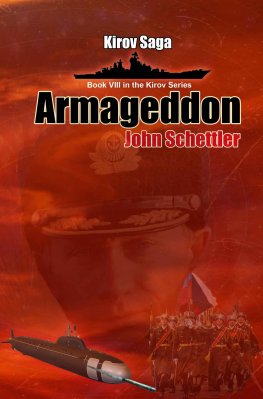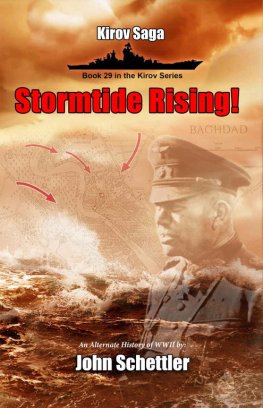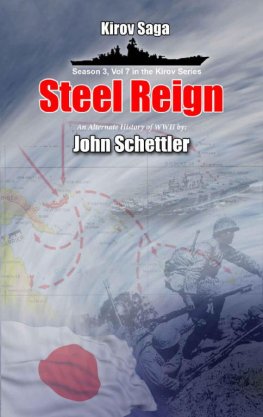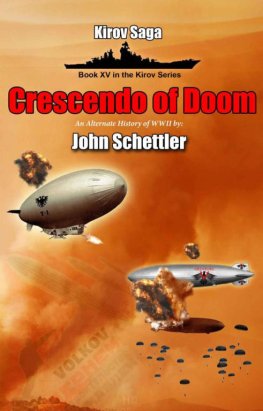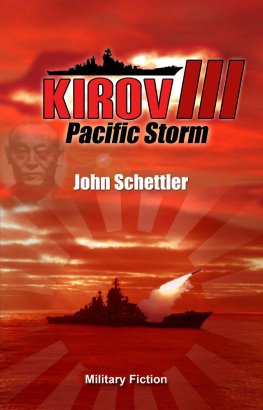Kirov Saga
NINE DAYS FALLING
Volume I
by John Schettler
Nine days they fell: Confounded Chaos roared,
And felt tenfold confusion in their fall
Through his wild anarchy, so huge a rout
Encumbered him with ruin: Hell at last
Yawning received them whole, and on them closed;
Hell, their fit habitation, fraught with fire
Unquenchable, the house of woe and pain.
~ Milton,
Paradise LostIf the facts dont fit the theory, change the facts.
~ Albert Einstein
The Kirov Series as it is now conceived begins with the opening Kirov trilogy, which focuses on the long odyssey through time to the 1940s by the Russian battlecruiser Kirov. Book I covers action in the North Atlantic, Book II covers the Mediterranean, and book III the Pacific. The fourth book in the series, Men Of War, recounts what happened to the ship and principle crew members after their return to the year 2021. As such it is a kind of bridge novel that leads the story into the modern day presentation of the dreadful war in a second trilogy entitled 9 Days Falling.
The crew of Kirov learned of this war, and how it was to begin, during their journey, and they came to suspect that their own actions in the past gave birth to the catastrophic future they discovered. The strange disappearance and sudden return of the battlecruiser were critical factors in igniting the tinder dry political situation in 2021, where an energy starved world gears up for the first great global conflict of the new century. At the end of book III, Pacific Storm, Karpov realizes that, in some other cycle of these events, he may have been the man who triggered the war by firing on the US submarine Key West. The main characters have all seen the awful consequences of this war on one blackened shore after another, but they soon realize in Men Of War that the dreadful fall of the dominoes continues. Karpovs dramatic rehabilitation and restraint has only bought the world a brief respite, and the conflict begins with another flashpoint over the Diaoyutai / Senkaku Islands.
With foreknowledge of where this conflict will lead and the power to travel to the past still within their grasp, the storys main characters take upon themselves a great taskto see if they can discover how to prevent the war from ever happening. When they learn that the surly Chief Gennadi Orlov is still alive in the 1940s, Fedorov is convinced that his presence there can do no good, and the deepening mystery and utility of Rod-25 allows him to launch a daring mission to the past to try to find Orlov and bring him home. He will find much more than he bargained for, but all that lies ahead in the story, which brings me to my next thoughts.
These novels present an alternate history of events taking place in the 1940s, and a fictional depiction of a war taking place in the year 2021. The action in the past is also not in sync, on a day by day basis, with the action in 2021, as Fedorov notices that time seems to move at a different pace and does not respect our calendar. This effect was very obvious each time Kirov shifted to the past and returned to the dark future that was conceived by their actions. Things happen earlier or later than they might have, and sometimes they dont occur at alllike the Japanese attack at Pearl Harbor that Kirovs action in the North Atlantic wipes from the history books.
The research involved in trying to make a story like this ring true is considerable. It required discovery of the exact deployment of the Royal Navy on the date that Kirov appears in 1941, and then extended to the principle officers and even individual crew members and pilots on those ships.
Sun and moon data for all dates in the story were determined, and even prevailing weather data when I could find it. Navigation charts for all restricted waters were researched. All buildings, facilities, inns and street names on land settings were fished from the Internet. The placement of vessels in any given port, and shore batteries involved in the action are all accurate, except where I deliberately moved ships as a result of Kirovs actions. The capabilities of naval systems and weapons, their ranges, lethality and armor penetration were all calculated.
A former professional war game designer, I spent a lot of time simulating potential battle outcomes, and expenditure of Kirovs limited inventory of missiles and shells were tracked in every engagement, round by round. Flight time of missiles after launch and of aircraft on strike missions to determine time on target were also computed, sometimes down to the second. Naval ranks, uniforms, caps, insignia, call signs, codes, flags and procedures were also part of the research.
That said, while I have worked hard to give the novels a strong historical underpinning, I have also changed the history you may know as I craft this tale, and this was done deliberately to serve the story. In some ways the altered reality will be remarkably faithful in reflecting the real history, in other places dramatically different, like a cracked mirror. The big changes on the strategic level are quite apparent: the United States enters the war in August of 1941 and there is no attack on Pearl Harbor. Admiral Yamamoto adopts Yamashiros plan and decides to strike south at Noumea and Darwin, discarding the Midway operation. Yamamoto survives the war and is instrumental in persuading the Emperor to order the surrender of Japan. The war ends without the use of the Atomic bomb.
On the operational level the air attacks on Petsamo and Kirkenes and the planned landing at Dieppe are both cancelled, along with a number of other minor operations like Operation Agreement and the planned attacks against airfields on Rhodes. In the Atlantic, Admiral Tovey sorties with major elements of the Home Fleet on two occasions, and in the Med Operation Pedestal sees Syfrets Force X turn back hours early and involved in a major surface action with Kirov.
Ships sustain damage or are sunk by Kirov, and others are redeployed to deal with the threat the mysterious raider poses. Repulse and Prince of Wales are not sent to the Pacific to be sunk by the Japanese as in our time line, and Repulse is instead sunk by Kirov, in the Atlantic while Prince of Wales survives the war. The US carrier Wasp, battleship Mississippi, cruisers Quincy and Wichita, and numerous destroyers are sent to Davey Jones Locker by Kirovs powerful offensive punch. The Italian Navy also takes a few hard lumps, and moves and deploys capital ships that otherwise were kept in more secure ports in response to Kirovs sudden appearance. German U-Boats figure prominently in the action at several points in the story, and some are compelled to change their patrol routes and tactics due to their interaction with Kirov.
Beyond these things, there are many other fine cracks in the mirror of history in this story. As Einstein suggested, I have changed the facts when they didnt fit the theory I was laboring to bring to life. Astute readers in the UK will quickly note that the story also references a "Queen" and not a "King" in the 1940s. Another wonders why I have a character address Churchill as Sir Winston when he wasnt knighted until 1953. This is intentional, as in this alternate history King George VI is killed when a bomb landed near a Buckingham Palace courtyard. The eldest daughter of King George, Elizabeth, ascended the throne as a minor, but given the fact that she was not of age the Regency Act of 1937 declared Prince Henry, Duke of Gloucester, as Regent. However she was Queen in name and fact, and much loved, even before she comes of age.


